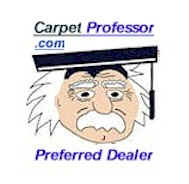How To Choose New Flooring Like A Pro!
Carpet | Vinyl Tile & Plank | Hardwood | Local Stores
(Free Information by Consumer Advocate - No Flooring Sales)
How To Locate Carpet Specifications
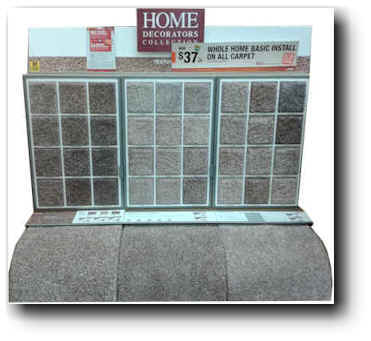 Understanding
Carpet Specifications is the ONLY sure-fire way for you to know if the carpet
you select is able to tolerate your level of foot traffic. Knowing
just a little bit
about carpet specifications will help you determine its value, durability and
longevity.
Understanding
Carpet Specifications is the ONLY sure-fire way for you to know if the carpet
you select is able to tolerate your level of foot traffic. Knowing
just a little bit
about carpet specifications will help you determine its value, durability and
longevity.
Many homeowners choose carpet incapable of meeting their needs, goals and lifestyle. They make their choice based on cost, softness and appearance rather than material quality, construction methods and workmanship. All carpets look and feel great when new but it's hard to tell if one carpet is more durable than another just by looking at it or feeling how soft it is. The only way to accurately measure the difference in quality between two similar carpets is to compare carpet specifications side by side.
The Carpet "Specification" Label Explained
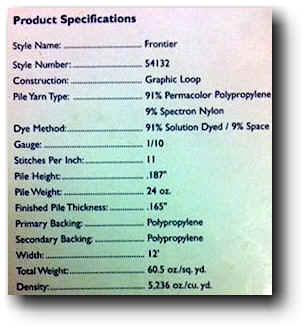 On
the backside of retail Carpet Samples there should be a
manufacturer's label that lists the following information:
On
the backside of retail Carpet Samples there should be a
manufacturer's label that lists the following information:
-
Type of Fiber
-
Pile Density
-
Face-Weight
-
Pile Height
-
Tuft Twist
This is must-have information that every homeowner needs to help determine how durable the carpet is, to help determine its value; and determine whether or not it would be a suitable choice to meet your needs, goals and lifestyle.
Where to Find Carpet Specifications?
Sometimes locating carpet specifications can be difficult. Some carpet retailers and salespeople are reluctant to provide complete carpet specifications to their customers. I would avoid buying from any carpet source that is not willing to provide carpet specifications when asked. There are several ways to obtain the information you need:
3 Ways Dealers Get Carpet Specifications
1. Dealers can call the Carpet Manufacturer directly – most carpet mills are happy to fax or email the carpet " spec sheet". You can also call the carpet manufacturer yourself as long as you have the main information about the carpet in question; The manufacturer and the carpet style. (For example: Mohawk, Elegant Moments EA124)
2. Flooring Dealers can login to their online carpet mill account - to gain access to carpet specifications. This may require a store manager to login to obtain the information you want. It's quite easy for them to do, if they are willing to take a few minutes to make it happen.
3. Dealers can call their Carpet Mill Representative to obtain the information you need. Every carpet retailer has the cell phone number and email address to contact their carpet mill account representative. It may take a day or two for their mill rep to provide the carpet specs you want, but they all have access to this information.
When Should I Ask For Carpet Specs?
It's not realistic to ask for specifications for every carpet they have on display in their showroom. You should narrow down your search before you begin asking for carpet specifications for individual samples.
You can use any of these factors to help narrow down your choices:
-
Price Range: (Carpet only price or total cost for carpet, pad and installation)
-
Fiber type: (Nylon, Polyester, Olefin, Sorona / Triexta, wool, etc.)
-
Pile Density: Face-Weight and Pile Height Rating
-
Face-Weight: (Total fiber weight, not including backing)
-
Pile Height: (Fiber measured from the backing up to the pile surface)
-
Tuft Twist: (number of twists per lineal inch of tuft)
or you could use characteristics such as...
-
Brand: (Mohawk, Stainmaster, Dream Weaver, Shaw, Fabrica, etc.)
-
Color or combination of colors (specific or generalized)
-
Style, Pattern or Texture
Technical factors including...
-
Stain Treatment (Scotchgard, R2X, DuraTech, Hydrophobic)
-
Styles with reduced foot prints or vacuum marks
-
Availability (in stock or shipped from the mill?)
-
Popularity (you saw it somewhere and really liked it)
-
Warranty Coverage (manufacturing or installation limits)
or any combination of these characteristics.
Narrowing down your final carpet choices...
You must narrow down your carpet choices to reduce the amount of time you spend shopping to prevent getting burned-out. If it were me, I would start by deciding what type of fiber I want first. I would tell the salesperson that I only want to look at carpets made of NYLON (because it is the most durable fiber).
Next I would choose the basic carpet style I want such as: Plush, Frieze, Patterned, Berber, or Cut and Loop... I prefer Frieze styles because they have a higher tuft twist rating (6 or higher) which makes the carpet more durable.
Next I would to narrow it down further by limiting my choices to carpets within a certain price range of perhaps $35 to $40 per square yard ($3.80 to 4.35 per square foot). This will reduce my options to a much smaller number of suitable carpet samples to consider. Now I can narrow it down even further by considering things such as colors I like or patterns and textures. I can narrow it down further if I only look at off-white colors. Anytime along your journey you can change your mind and start this process all over again. This is a major purchase and you need to be completely satisfied with your final selection.
Most homeowners take a few carpet samples home to consider and gradually narrow down their selections to three or four really good choices and then ask the salesperson to provide the spec-sheets for those. Now I can use the manufacturer's specifications to narrow it down even further. It may become obvious which carpet is the best choice, or the final choice will be decided by a flip of a coin. Specifications will allow you to know exactly what you are getting for your hard-earned money! When you get to this point, you may want to use my free Carpet Durability Guide to help determine which carpet you are considering is more capable of meeting all your needs and goals.
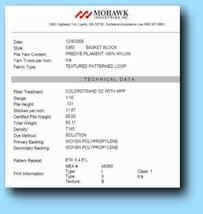 Getting
the Manufacturer's Spec-Sheet may take a day or two. Carpet manufacturers
are
not putting the detailed construction information on their carpet samples
like they used to in the past, but any decent carpet salesperson should be happy
to get you the information you seek. However, you may have to be
patient and wait for the information to be acquired, and it may take a little
time for the salesperson to get it. In the mean time, put those carpet
samples to the test and see how they look under different lighting situations in
your home.
Getting
the Manufacturer's Spec-Sheet may take a day or two. Carpet manufacturers
are
not putting the detailed construction information on their carpet samples
like they used to in the past, but any decent carpet salesperson should be happy
to get you the information you seek. However, you may have to be
patient and wait for the information to be acquired, and it may take a little
time for the salesperson to get it. In the mean time, put those carpet
samples to the test and see how they look under different lighting situations in
your home.
Take your time making your final selection and don’t feel pressured, even if you take a week or two to think things over. It’s common for pushy salespeople to say the sale is ending soon or the price is going up, blah blah blah!
The Salesperson Can't Locate the Specifications?
Most homeowners never ask for carpet specifications and your salesperson may be a bit surprised when you do. However, if the salesperson can't or refuses to provide you with the specs you ask for, then you might want to shop elsewhere. If your salesperson is new or inexperienced, then they may not know how to obtain the spec sheet from the carpet mill. In any case, the store manager or owner will know how to get the information you request.
Carpet manufacturers are happy to provide carpet specifications to their dealers and homeowners either by phone, fax, snail mail, email or on the web. You may need to be patient and give the salesperson sufficient time to make the call and get the information. (It may take a day or two)
Call the Carpet Manufacturer Yourself!
Don't take no for an answer! You can always call the carpet manufacturer yourself and ask for the carpet specifications! You just need the carpet brand name (the manufacturer), the item #, and the style name to get the spec sheet.
For Example:
"Mohawk" is the Brand,
"3J92" is the Style Number
"Blended Moments" is the Style Name.
Who to Call? Here is my List of Carpet Mills and their contact information. Ask to have your carpet spec-sheets delivered via email for fastest response.
__________________________________________________________________________
1. What is Carpet Pile Height?
If you want your carpet to last longer and resist matting and crushing of the pile, I recommend a Carpet Pile Height of 3/4" or less. On stairs, I recommend a Carpet Pile Height of 1/2" or less and a Carpet Padding Thickness of 7/16" or less and a Pile Density Rating of at least 8-pounds. The Pile Height measurement is not always shown on the carpet sample, however all you need is a tape measure. Don't include the carpet backing, just measure the soft fibers from the backing up.
Keep The Pile Low
A Shorter Pile-Height makes for a more durable carpet. It also makes the carpet easier to clean, more stain resistant and less prone to matting and crushing of the pile.
FYI: Commercial Grade Carpet is well-known for having a short pile-height and a dense pile. Commercial carpet is usually glued down over concrete without using any padding. The low pile height is the secret for success used in offices, airports, casinos and banks to name a few. Without any padding underneath, the carpet cannot develop wrinkles which makes it perfect for heavy foot-traffic areas. It is not soft underfoot at all but it is super durable.
2. What is Carpet Pile Density?
Pile Density is a mathematical calculation based on the fiber Face-Weight and Pile Height. Think of a heavily wooded forest. The more closely packed together the trees are, the more dense the forest is. The same goes for carpet. You want a carpet with the tufts packed tightly together. This helps the carpet resist matting and crushing of the pile and increases durability and longevity. Pile Density is a major factor to consider when it comes to carpet durability too, almost as important as the type of Carpet Fiber you select.
3. What is Carpet Face-Weight?
Face-weight is the actual weight of the fiber used to manufacture the carpet pile, but does not include the weight of the carpet backing. Fiber Face-weight is not the same as Total Carpet Weight, which includes the weight of the carpet backing and the fiber face-weight.
Most carpets have a face-weight somewhere between 20 ounces and 100 ounces, but the typical face-weight for residential carpet is 30 to 60 ounces. A higher face-weight does not automatically mean the carpet is a better grade; is a higher quality; is more durable; or is more costly. These three carpet specs are mathematically related which is good news for you. If you can figure out one or two, out of the three specs, then you can easily figure out the other specifications using the formulas I reveal below!
4. What is Tuft Twist?
Carpet fiber is either extruded or twisted to form a single strand or "filament". These filaments are similar in size to a human hair. A bunch of filaments are grouped together and twisted together to form Tufts. While the fiber strands are twisted, heat is applied to "set" them permanently, hence the term "heat set" or "perm". The tighter the tufts are twisted together the longer the carpet is able to maintain its "like-new" appearance. The Tufts illustrated below are one-inch long. I have used two colors to help show the number of twists.
The Tuft Twist Rating
Based on the number of twists per lineal inch of tuft.
This Tuft has 7 twists and is a sign of a more durable carpet. Frieze styles have tufts similar to this and cost about $35 per square yard and up, or $3.88 per square foot. More expensive carpet styles tend to have higher Tuft-Twist ratings.
This Tuft has 4 twists and is not as durable or long lasting. Low to medium grade Plush and Textured Plush styles often have a tuft twist rating similar to this and range from $15 per square yard or $1.66 per square foot and up.
Carpets rarely wear out from fiber loss, they just start to mat down; gradually lose the luster and shine; and just start to look bad or ugly. Once the tufts have blossomed and become matted down, the damage cannot be undone, reversed or repaired.
Learn more Carpet Manufacturing Specifications Explained
Points To Remember:
-
The Tuft Twist Rating is based on the number of twists per lineal inch of the tuft. If a tuft is only a half inch long, you would need to double the twist count to determine the twist rating.
-
The Tuft Twist count usually range from 3.0 to 7.5. Lesser quality carpets will have a lower number of Tuft Twists. The higher the Tuft Twist the longer your new carpet will retain its like-new appearance.
-
Carpet "Blossom" or blooming is a common carpet condition where the Tuft begins to un-twist and starts to look worn out, matted down and ugly!
-
Some carpets with a lower Tuft twist rating may feature a higher pile density to try to compensate. A higher Pile Density will help increase the longevity and durability. Manufacturers of Polyester and PET Polyester carpets often use this strategy to lower costs and increase carpet durability with limited results.
-
You will find that carpets made from PET Polyester and Polyester fibers are less expensive than a Nylon counterpart and yet feel softer and provide a higher pile density than Nylon. Polyester is less inexpensive to manufacture. This is why they can afford to create a carpet that is more dense and less costly than Nylon.
Pile Height, Density and Face-Weight
Not having all three of these specs readily available to you might not be such a big problem if you can find or even closely guesstimate two out of three carpet specifications, then you can calculate the third specification...by using simple mathematics!
Below I explain in detail what you need to do, and how you can quickly and easily figure out for yourself all the carpet specifications you need to acquire, even if the carpet retailer or salesperson refuses to give you hardly any information at all!
Why is Tuft Twist Important?
The Number of Tuft Twists is an important factor to making sure your carpet retains its like new appearance longer. Frieze styles tend to have a higher tuft twist (over 6 twists per lineal inch) and is why they are well-known for their durability and retaining a like-new appearance longer than many other styles.
Count The Twists Yourself!
When you look at a potential carpet, you can look closely at the tuft and count the number of twists yourself. Just remember that the tuft twist rating is based on one inch of tuft. For example, if the tuft is 1/2" long and has 3 twists, then the tuft twist is 6.
Looped Berber carpets have twisted tufts too, but it is very hard to count them with the naked eye. Most looped Berber styles will state the Tuft Twist Rating posted on the back of the carpet sample or shown on the manufacturer's spec sheet. (ask for it)
Matting and Crushing
Carpets with a lower Tuft Twist Rating (less than 5), tend to untwist or “blossom” at the tuft tips more quickly, thus creating a worn out, frizzy looking or matted down appearance.
________________________________________________________________
Carpet Durability Guide Chart
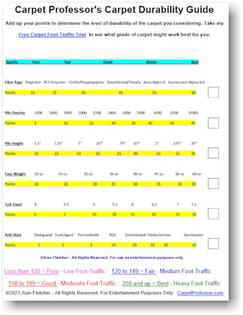 If you want to make
wise and informed choices you need to know
what grade or quality level of carpet you need to buy for your home. (Click
on the image to view or print)
If you want to make
wise and informed choices you need to know
what grade or quality level of carpet you need to buy for your home. (Click
on the image to view or print)
What is your foot traffic score? Here's a simple test to help you determine your level of foot-traffic you have in your home. It just takes a minute or two to take my free Carpet Foot-Traffic Test.
Then you can use my free Carpet Durability Chart to determine if the carpet you are considering is capable of meeting your needs and goals.
________________________________________________________________
Learn more:





